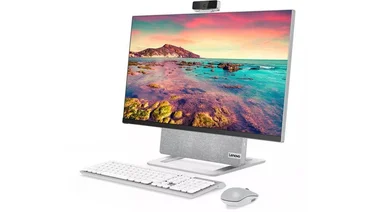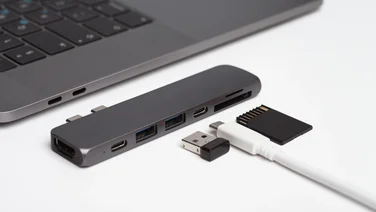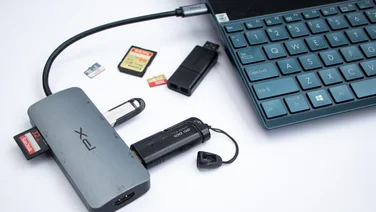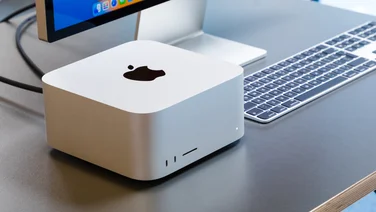To help us provide you with free impartial advice, we may earn a commission if you buy through links on our site. Learn more

- Good selection of ports
- Powerful enough for daily use
- Cheap
- No SSD storage
The Neo J50C-4 is clearly a close relative of the Neo G41V-4. Both are low-powered, very cheap Windows 10 Pro systems, and they even have the same squat shape, down to identical width and depth dimensions. Look closer at both of these mini PCs and you’ll find differences, both inside and out. Besides having a completely distinct connection layout, the Neo J50C-4 adopts a more upgrade-friendly internal design and has an even more obscure CPU than the Neo G41V-4’s fanless Celeron chip.
Editor’s note: This article frequently refers to our review of the Minix Neo G41V-4, which can be found by following this link.
Minix Neo J50C-4 review: Specifications and performance
The Intel Pentium Silver J5005 is a quad-core, four-thread processor, and while it’s not the most popular of Intel CPUs, it has a handful of advantages over the Celeron N4100. Both the base clock speed and maximum boost speed are higher, at 1.5GHz and 2.8GHz respectively, and its integrated UHD Graphics 605 has a marginally faster boost speed than the Celeron’s UHD Graphics 600.
Not, admittedly, that this makes the Neo J50C-4 much good at running even simple AAA games. Dirt Showdown failed to reach a playable frame rate at 1080p with Ultra quality settings, averaging just 14fps, and this only rose to 17fps when we switched to 720p and the High quality settings.

In our more CPU-focused 4K benchmarks, the Neo J50C-4’s higher clock speeds gave it a little push up to 57 in the image test, but its video test score of 45 and multitasking score of 18 were both identical to those of the Neo G41V-4, leading to a barely higher overall score of 33.
That said, at this low level, every little helps, and since any sane user would only use the Neo J50C-4 for basic, mainly single-core applications such as browsers and word processors, it’s definitely the better of the two Minix systems from a general performance perspective. It has the same, very modest 4GB of RAM as well, although there’s another benefit to choosing the Neo J50C-4 here: it can be upgraded.
Minix Neo J50C-4 review: Features and connectivity
Yes, although there’s no convenient flap for quickly installing or uninstalling an SSD as there is on its sibling, opening up the Neo J50C-4 grants access to both the M.2 slot and two SO-DIMM slots for memory, in direct contrast to the Neo G41V-4, which has its RAM soldered in and out of reach. Once again, getting inside involves removing the feet and loosening the screws underneath, but this is easy if you have the right size of screwdriver.
Since boosting the RAM up to 8GB or even 16GB is both doable and inexpensive, we’d strongly recommend it. At £300, the Neo J50C-4 doesn’t need to go head to head with the Quiet PC UltraNUC 8 Pro Fanless or Dell Optiplex 7060 Micro, both of which are more than twice as expensive, but in its out-of-the-box state, on occasion it can feel more sluggish, and more memory would help reinforce its particular shaky multitasking.
On a similar note, an extra SSD would be extremely useful as well. The Neo J50C-4 matches the Neo G41V-4 in only offering 64GB of eMMC storage as standard, and with Windows installed on it, you’ll only have a paltry 33GB free for programs and files. The Chromebox CXI3 has a comparable ailment, but Windows doesn’t have the same focus on space-saving cloud software that Chrome OS does. This Flash drive is also considerably slower than even a SATA-based SSD, recording a sequential read speed of 292MB/s and a sequential write speed of 229MB/s.
None of this is to detract too much from the Neo J50C-4’s strengths, particularly its flexibility. For one thing, it can – like the CXI3 – be VESA-mounted, such as to the rear of a monitor, and includes a mounting kit in the box for this very purpose. And, although its array of external ports isn’t vast in number, it’s more varied than most PCs of its size, including the CXI3 and the Neo G41V-4.

For example, while it has only three full-size USB ports, fewer than even the Raspberry Pi 4 Model B, they’re all USB3 instead of slower USB2, and it makes up the numbers with a USB Type-C port as well. This is a multi-talented port too, as it can output 4K video at 60Hz. Display support is made even better by the inclusion of separate HDMI and mini DisplayPort outputs, allowing for up to three 4K displays at once, and the 3.5mm audio jack can, like the Neo G41V-4, be installed with an S/PDIF adaptor.
The final port is a Gigabit Ethernet jack, but there’s built-in 802.11ac Wi-Fi as well, plus Bluetooth 4.1. The low number of USB ports might not be as much of an issue, then, if you have a Bluetooth mouse and keyboard you can use in place of wired peripherals.
Minix Neo J50C-4 review: Verdict
The Neo G41V-4 also has lots of video outputs and some other perks, such as a microSD slot, but its lack of USB Type-C and the use of VGA makes the Neo J50C-4 look like the more forward-thinking model. Fine, it doesn’t have an SSD flap. But it’s faster in exactly the kinds of software that a cheap mini PC would be appropriate for, and it isn’t going to be stuck with 4GB of RAM for life.







